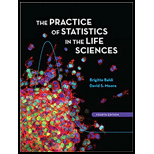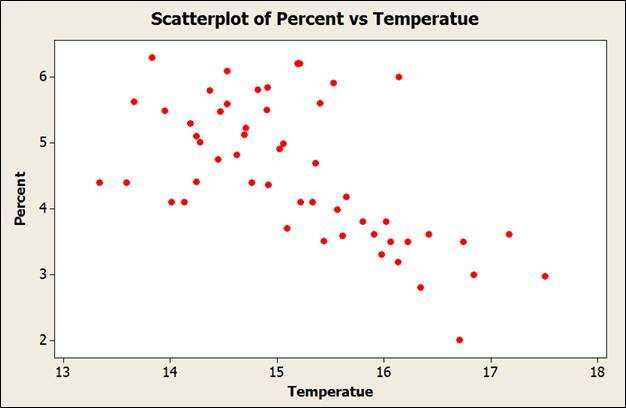
a.
To explain: The type of graph could be used to explain the relationship between the two variables.
a.
Explanation of Solution
Given:
The data set is:
| Temperature | Percent |
| 13.34 | 4.39 |
| 13.59 | 4.39 |
| 13.66 | 5.63 |
| 13.83 | 6.3 |
| 13.95 | 5.49 |
| 14.01 | 4.1 |
| 14.13 | 4.1 |
| 14.19 | 5.29 |
| 14.24 | 5.1 |
| 14.24 | 4.41 |
| 14.28 | 5.01 |
| 14.37 | 5.8 |
| 14.45 | 4.75 |
| 14.47 | 5.48 |
| 14.53 | 6.09 |
| 14.53 | 5.59 |
| 14.62 | 4.82 |
| 14.69 | 5.12 |
| 14.71 | 5.23 |
| 14.76 | 4.39 |
| 14.82 | 5.81 |
| 14.9 | 5.5 |
| 14.91 | 5.84 |
| 14.92 | 4.36 |
| 15.02 | 4.91 |
| 15.06 | 4.99 |
| 15.09 | 3.7 |
| 15.19 | 6.21 |
| 15.21 | 6.21 |
| 15.22 | 4.1 |
| 15.33 | 4.1 |
| 15.36 | 4.69 |
| 15.4 | 5.6 |
| 15.44 | 3.51 |
| 15.53 | 5.91 |
| 15.56 | 3.99 |
| 15.61 | 3.59 |
| 15.65 | 4.18 |
| 15.8 | 3.8 |
| 15.91 | 3.61 |
| 15.98 | 3.3 |
| 16.02 | 3.8 |
| 16.06 | 3.49 |
| 16.13 | 3.19 |
| 16.14 | 6 |
| 16.22 | 3.5 |
| 16.34 | 2.8 |
| 16.42 | 3.61 |
| 16.71 | 2 |
| 16.74 | 3.5 |
| 16.84 | 3 |
| 17.17 | 3.61 |
| 17.51 | 2.97 |
The
b.
To compare: The analysis for the 2D system with that of 3D system and explain whether 3D program is an improved version over the 2D version.
b.
Explanation of Solution
In this case, temperature is an explanatory variables as it does not get affected by any other variables
Graph:
The scatter plot for the provided variables can be constructed as:

From the scatter plot constructed above,
Direction: There is a negative association between the two variables
Form: There is approximately linear relationship between the variables.
Strength: There is a moderate negative relationship between variables
c.
To find: The numerical value of the correlation, if possible and explain the association using the value of the
c.
Explanation of Solution
The correlation using the mentioned steps of Excel below can be calculated as:
- Enter the data set in the Excel sheet.
- Click on Data > Data Analysis.
- Select “Correlation” from the drop down menu.
- Select input
range . - Click OK.
The obtained output is:

Thus, the correlation coefficient ( r ) is approximately -0.62. Thus, it is confirmed that there is a moderate
Want to see more full solutions like this?
Chapter 3 Solutions
Practice of Statistics in the Life Sciences
- Let X be a random variable with support SX = {−3, 0.5, 3, −2.5, 3.5}. Part ofits probability mass function (PMF) is given bypX(−3) = 0.15, pX(−2.5) = 0.3, pX(3) = 0.2, pX(3.5) = 0.15.(a) Find pX(0.5).(b) Find the cumulative distribution function (CDF), FX(x), of X.1(c) Sketch the graph of FX(x).arrow_forwardA well-known company predominantly makes flat pack furniture for students. Variability with the automated machinery means the wood components are cut with a standard deviation in length of 0.45 mm. After they are cut the components are measured. If their length is more than 1.2 mm from the required length, the components are rejected. a) Calculate the percentage of components that get rejected. b) In a manufacturing run of 1000 units, how many are expected to be rejected? c) The company wishes to install more accurate equipment in order to reduce the rejection rate by one-half, using the same ±1.2mm rejection criterion. Calculate the maximum acceptable standard deviation of the new process.arrow_forward5. Let X and Y be independent random variables and let the superscripts denote symmetrization (recall Sect. 3.6). Show that (X + Y) X+ys.arrow_forward
- 8. Suppose that the moments of the random variable X are constant, that is, suppose that EX" =c for all n ≥ 1, for some constant c. Find the distribution of X.arrow_forward9. The concentration function of a random variable X is defined as Qx(h) = sup P(x ≤ X ≤x+h), h>0. Show that, if X and Y are independent random variables, then Qx+y (h) min{Qx(h). Qr (h)).arrow_forward10. Prove that, if (t)=1+0(12) as asf->> O is a characteristic function, then p = 1.arrow_forward
- 9. The concentration function of a random variable X is defined as Qx(h) sup P(x ≤x≤x+h), h>0. (b) Is it true that Qx(ah) =aQx (h)?arrow_forward3. Let X1, X2,..., X, be independent, Exp(1)-distributed random variables, and set V₁₁ = max Xk and W₁ = X₁+x+x+ Isk≤narrow_forward7. Consider the function (t)=(1+|t|)e, ER. (a) Prove that is a characteristic function. (b) Prove that the corresponding distribution is absolutely continuous. (c) Prove, departing from itself, that the distribution has finite mean and variance. (d) Prove, without computation, that the mean equals 0. (e) Compute the density.arrow_forward
- 1. Show, by using characteristic, or moment generating functions, that if fx(x) = ½ex, -∞0 < x < ∞, then XY₁ - Y2, where Y₁ and Y2 are independent, exponentially distributed random variables.arrow_forward1. Show, by using characteristic, or moment generating functions, that if 1 fx(x): x) = ½exarrow_forward1990) 02-02 50% mesob berceus +7 What's the probability of getting more than 1 head on 10 flips of a fair coin?arrow_forward
 MATLAB: An Introduction with ApplicationsStatisticsISBN:9781119256830Author:Amos GilatPublisher:John Wiley & Sons Inc
MATLAB: An Introduction with ApplicationsStatisticsISBN:9781119256830Author:Amos GilatPublisher:John Wiley & Sons Inc Probability and Statistics for Engineering and th...StatisticsISBN:9781305251809Author:Jay L. DevorePublisher:Cengage Learning
Probability and Statistics for Engineering and th...StatisticsISBN:9781305251809Author:Jay L. DevorePublisher:Cengage Learning Statistics for The Behavioral Sciences (MindTap C...StatisticsISBN:9781305504912Author:Frederick J Gravetter, Larry B. WallnauPublisher:Cengage Learning
Statistics for The Behavioral Sciences (MindTap C...StatisticsISBN:9781305504912Author:Frederick J Gravetter, Larry B. WallnauPublisher:Cengage Learning Elementary Statistics: Picturing the World (7th E...StatisticsISBN:9780134683416Author:Ron Larson, Betsy FarberPublisher:PEARSON
Elementary Statistics: Picturing the World (7th E...StatisticsISBN:9780134683416Author:Ron Larson, Betsy FarberPublisher:PEARSON The Basic Practice of StatisticsStatisticsISBN:9781319042578Author:David S. Moore, William I. Notz, Michael A. FlignerPublisher:W. H. Freeman
The Basic Practice of StatisticsStatisticsISBN:9781319042578Author:David S. Moore, William I. Notz, Michael A. FlignerPublisher:W. H. Freeman Introduction to the Practice of StatisticsStatisticsISBN:9781319013387Author:David S. Moore, George P. McCabe, Bruce A. CraigPublisher:W. H. Freeman
Introduction to the Practice of StatisticsStatisticsISBN:9781319013387Author:David S. Moore, George P. McCabe, Bruce A. CraigPublisher:W. H. Freeman





